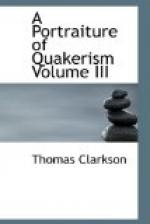The next subject, which comes to us in order, is dancing. This is handed down to us, under two appearances, either as it is simple, or as it is connected with preparations and accompaniments.
In viewing it in its simple state, it is no where contended, if it be encouraged on the principle of promoting such an harmonious carriage of the body, or use of the limbs, as maybe more promotive of health, that it is objectionable, though it is supposed that it is not necessary for such purposes, and that, without music and its other usual accompaniments, it would not be pleasant. Neither is it contended that a simple dance upon the green, if it were to arise suddenly and without its usual preparations, may not be innocent, or that if may not be classed with an innocent game at play, or with innocent exercise in the fields, though it is considered, that it would hardly be worthy of those of riper years, because they who are acknowledged to have come to the stature of men, are expected to abandon amusements for pursuits of usefulness, and particularly where they make any profession of the Christian name.
In viewing it with its preparations, and with its subsequent accompaniments, as usually displayed in the ball-room, we see it in a less favourable light. We see it productive, where it is habitually resorted to, of a frivolous levity, of vanity and pride, and of a littleness of mind and character. We see it also frequently becoming the occasion of the excitement of the malevolent passions, such as anger, envy, hatred, jealousy, malice, and revenge. We find it also frequently leading to[57] indisposition. We find lastly, that, in consequence of the vexation of mind, which may arise from a variety of causes, but more particularly from disappointment and the ascendency of some of the passions that have been mentioned, more pleasure is generally perceived in the anticipation of these amusements, than in the actual taste or use of them.
[Footnote 57: Not only colds, head-aches, and a general lassitude, ore the result Of dancing in ball-rooms, but occasionally serious indisposition. I have known the death of two young persons attributed to it by the physicians who attended them in their illness.]




